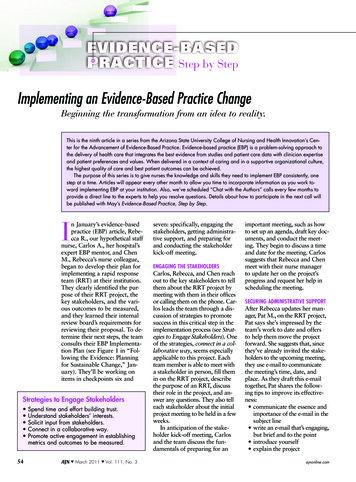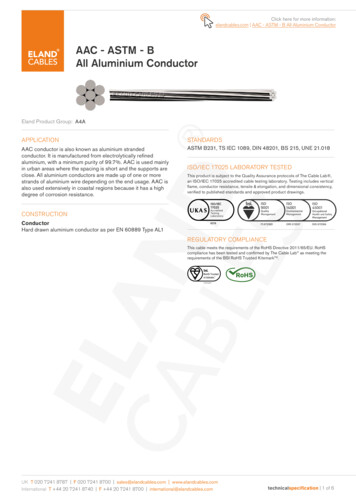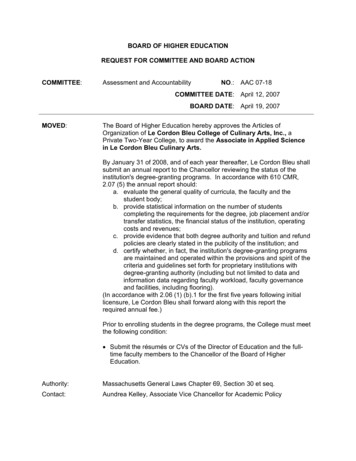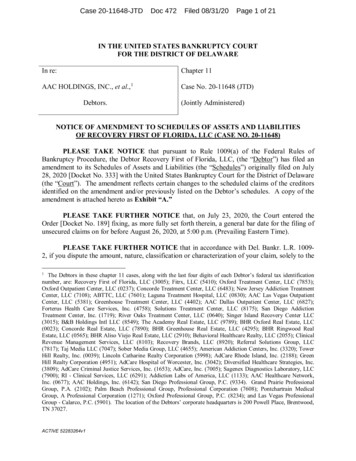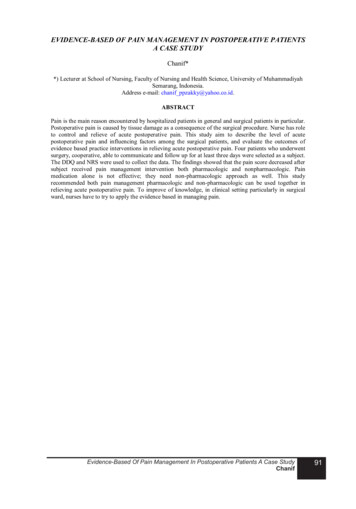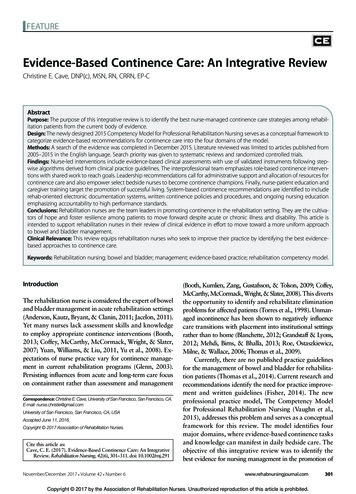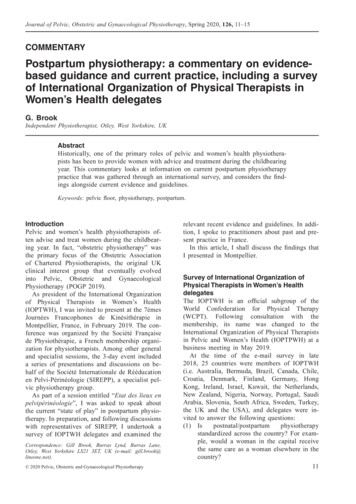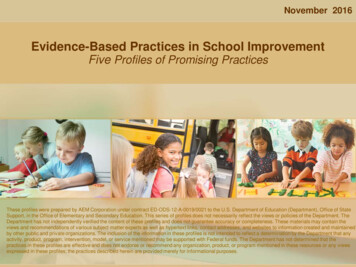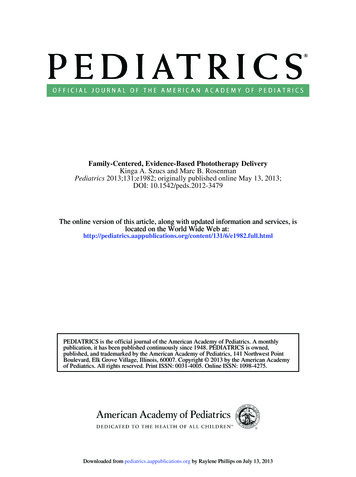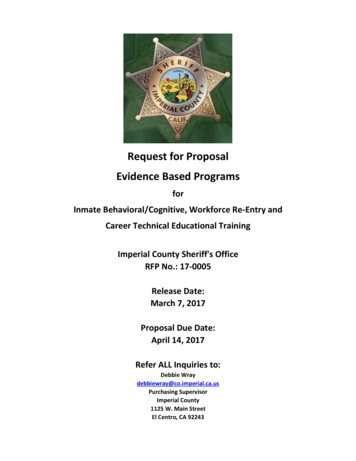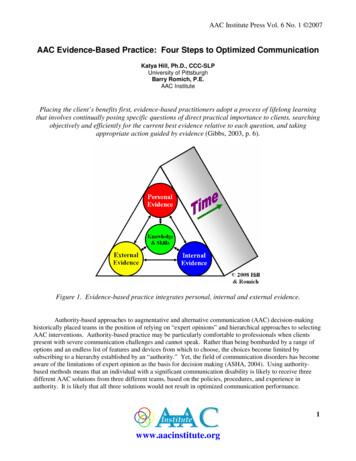
Transcription
AAC Institute Press Vol. 6 No. 1 2007AAC Evidence-Based Practice: Four Steps to Optimized CommunicationKatya Hill, Ph.D., CCC-SLPUniversity of PittsburghBarry Romich, P.E.AAC InstitutePlacing the client’s benefits first, evidence-based practitioners adopt a process of lifelong learningthat involves continually posing specific questions of direct practical importance to clients, searchingobjectively and efficiently for the current best evidence relative to each question, and takingappropriate action guided by evidence (Gibbs, 2003, p. 6).Figure 1. Evidence-based practice integrates personal, internal and external evidence.Authority-based approaches to augmentative and alternative communication (AAC) decision-makinghistorically placed teams in the position of relying on “expert opinions” and hierarchical approaches to selectingAAC interventions. Authority-based practice may be particularly comfortable to professionals when clientspresent with severe communication challenges and cannot speak. Rather than being bombarded by a range ofoptions and an endless list of features and devices from which to choose, the choices become limited bysubscribing to a hierarchy established by an “authority.” Yet, the field of communication disorders has becomeaware of the limitations of expert opinion as the basis for decision making (ASHA, 2004). Using authoritybased methods means that an individual with a significant communication disability is likely to receive threedifferent AAC solutions from three different teams, based on the policies, procedures, and experience inauthority. It is likely that all three solutions would not result in optimized communication performance.1www.aacinstitute.org
AAC Institute Press Vol. 6 No. 1 2007For children and adults who rely on AAC, their life experience is and will be a function of their abilityto use language to communicate. People who use AAC tell us that the two most important values in their use ofAAC are 1) saying exactly what they want to say and 2) saying it as fast as they can. Parents with childrenwho rely on AAC share these same values (Hurd, 2005). When surveyed, individuals with disabilities andfamily members expressed a clear sense of maximizing potential and independence as an important outcome(Pain, Dunn, Anderson, Darrah, Kratochvil, 1998). In other words, they want to be “the best they can be”. TheAAC service delivery process must honor these values. Evidence-based practice provides the principles andprocess to honor and adhere to the goals, values, and expectations of individuals who benefit from AAC.A Model for AAC Evidence-Based PracticeAAC evidence-based practice (EBP) requires the collection, evaluation, and integration of the bestevidence available. The types of evidence used to drive the EBP process are critical to making decisions thatmake a difference to client outcomes. Recently, Dollaghan (2007) has recommended that three types ofevidence (E3) are essential to the EBP process: personal evidence, internal evidence, and external evidence.Figure 1 represents the synergy that occurs among these evidence categories when savvy clinicians apply E3BP.The EBP flow chart put forward in 2001 (Hill & Romich, 2002) has been revised to reflect Dollaghan’s threeessential evidence categories.The E3BP flow chart (Figure 2) serves as a systems model for clinical service delivery. The modelprovides the framework for following the four basic steps for E3BP: 1) asking meaningful EBP questions; 2)collecting and reviewing the personal and internal evidence; 3); locating and reviewing the externalevidence and 4) using the evidence to make assessment and intervention decisions. The model illustrateshow the processes identified by Sackett et al. (1997), when followed, provide for the collection of the personal,internal and external evidence needed for data-driven decisions.Develop Client ProfileThe process starts with characterizing the individual. Applying the principles of EBP is not possiblewithout a thorough assessment of the individual’s abilities, skills, expectations and values. Assessmentconcerns one of the most vital tasks in practice (Gibbs, 2003). Therefore, comprehensive information and datacollection and reporting are fundamental. Characterizing the individual is a crucial process that identifies,classifies and prioritizes the areas and issues associated with a communication disorder. No data are moreimportant to formulating and answering the best questions for an individual than data on language functioning.This clinical diagnostic course of action drives us toward specific evidence and AAC interventions. A primarypurpose of this step is to permit the retrieval of communication performance that others with similar profileshave been able to achieve.Step 1: Ask Meaningful EBP QuestionsA difference between an authority-based process and EBP is the desire to decrease the uncertainty inmaking clinical decisions about care. Rather than the presumption of knowing what is best, teams usequantitative data to guide evidence-based decisions. Teams applying EBP seek, appraise and integrate externalevidence. However, how can team members feel confident about the evidence they collect to make decisionsabout an individual’s life experience? Identifying evidence depends largely on something that happens beforethe search begins: namely, on how questions about evidence are framed (Dollaghan, 2007). Learning how toask meaningful questions that result in successful searches is the critical first step in the EBP process.Client-oriented questions are formulated that allow teams to search and evaluate the best evidence tobase recommendations about AAC interventions. Evidence-based medicine uses the PICO (Patient/Problem,Intervention, Comparison and Outcome) frame to structure questions (Sackett,et al., 2000). Gibbs (2003)recommends a comparable question formulation strategy called COPES or Client-Oriented Practical EvidenceSearch. COPES reminds teams that evidence should have practical significance for applying treatment that willmake a difference in the achieved outcomes. Each strategy recommends the following four (4) elements for a2www.aacinstitute.org
AAC Institute Press Vol. 6 No. 1 2007well-built question: 1) the client type; 2) what you might do; 3) an alternative course of action or notreatment; 4) what you want to accomplish. As you identify what you want to accomplish, consider that the“best evidence” includes the critical performance measures important for monitoring client outcomes.Let’s take a closer look at the elements of well-formulated questions and some possible questions, thatwhen answered, would make a difference in the treatment outcomes. Table 1 shows examples of frequentlyasked question types related to AAC decisions based on Gibbs (2003). Being able to compare and contrastthe internal evidence collected as part of Step 2 and the external evidence located as part of Step 3 demonstrateshow important consistent and reliable measures of communication competence are for the process to lead tosuccessful results.Figure 2: Evidence-Based Practice (E3BP) Flow Chart3www.aacinstitute.org
AAC Institute Press Vol. 6 No. 1 2007Table 1. PICO / COPES question types with the four elements of a well-built question.Four Elements of a Well-Formulated QuestionQuestionTypeClient TypeHow would Idescribe a client ora group of clientswith a similarprofile? ningquestionDeliveryquestionFor personsrecently diagnosedwith ALS in Stage 2For school-agedchildren who relyon AAC,For a preschoolchild with autismusing an AACsystemFor teamsproviding AACevaluationsWhat You Might DoAlternative Courseof ActionPerform anassessment;Apply a treatment;Measure to assessabilities;Survey clients What You Want to AccomplishWhat is the mainalternative otherthan in the box tothe left?This may mean notreatment or nointervention.Exampleswould initiating theor postponing theassessment for highassessment untiltechnology AACspeech hasinterventions assignificantlysoon as possibledeterioratedwill language basedor activity basedtreatmenttreatmentOptimize communication?Maintain functions?Performance or outcome ofassessment or treatment?Reliable and valid measure?will a parent trainingprogramor a 1 day/weektraining withclassroom supportresult in significantly greater gains inexpressive language skills?will a languagebased assessmentmodelor a needs-basedassessment modelresult in AAC recommendations thatachieve optimal communication andreduce abandonment or disuse ofsystems?lead to significantly bettercommunication performance?lead to significantly greater corevocabulary gains?Step 2: Collect Personal Evidence and Internal EvidencePersonal evidence is collected by having the client and family identify their values, goals, andexpectations related to quality of life and use of AAC assistive technology. Internal evidence is collectedthrough quantitative analysis of language samples, resulting in performance data on how someone uses AACassistive technology and strategies. This step provides for baseline data prior to initiating any changes to currentstatus. Light and Binger (1998) emphasize the importance of language sampling and data collection to establishperformance baselines for individuals using AAC systems. LAM (language activity monitoring) refers tocollection and subsequent analysis and reporting of communication using an AAC system and/or AACstrategies. More specifically, LAM is a feature in an AAC system that supports the automated recording ofevents representing how an AAC system is used by an individual to communicate and thus provides reliable andvalid performance measures to support EBP (Hill, 2004).Step 3: Collect External EvidenceStep 3 expects that teams are committed to searching fairly and honestly for disconfirming andconfirming evidence (Gibbs, 2003). EBP requires that teams collect, interpret and integrate valid, important andapplicable evidence (McKibbon, Wilczynski, Hayward, Walker-Dilks, & Haynes, 1995). Research on clientswith similar profiles to the client in question that reports specific performance and outcome measures isparticularly valuable as evidence (Hill, 2006). A growing database of evidence reporting performance data tosupport AAC practice, specifically Step 3, is a resource available at the web site of the AAC Institute www.aacinstitute.org. The database reflects five Levels of Evidence based on the American Academy forCerebral Palsy and Developmental Medicine (AACPDM; Butler, 2001). However, the categories of evidencereflect the distinction between research that is based on individuals who rely on AAC and research this is not.4www.aacinstitute.org
AAC Institute Press Vol. 6 No. 1 2007For many, research results reporting performance data provide the most important and relevant evidence fordecision-making. Performance data provide the benchmarks to strive toward, to raise expectations, or tomotivate teams to go beyond the results for the benefit of the client.Why is evidence on performance data the most important and applicable evidence to use for making adecision about AAC practice? A performance-based understanding of communication competence has been along-standing goal of AAC. Historically, our understanding of communication competence has been based onthe collection and analysis of language samples. Reviewing the research assessing the performance ofindividuals who rely on AAC shows the practical significance of specific measures in monitoring results such aslanguage representation method use, vocabulary frequency, utterance generation strategies, and communicationrate. These parameters of performance are reliable and valid in measuring communication competence andevaluating the effectiveness of an AAC system for individuals whose natural speech is not meetingcommunication abilities and needs.Step 4: Use Evidence to Make Therapy DecisionsThis step involves monitoring the progress or results of implementing the recommended intervention(s).The performance and outcomes data selected and reported as baseline data are collected, analyzed, and reportedto make decisions about the success of the decisions by the team. Routine reporting of client performanceprovides for timely adjustments and modifications to the AAC assessment and intervention processes, thusensuring that the client is achieving maximum benefit. Finally, Step 4 moves teams away from authority-baseddecisions to evidence-based decisions. Decisions are no longer based on impressions of effectiveness, but onquantified performance.SummaryIn summary, EBP expects teams to conscientiously and judiciously use the best evidence or data tosupport decisions (Sackett, Rosenberg, Gray, Haynes, & Richardson, 1996). Personal and internal evidenceguide action that is of practical importance to clients. External evidence reporting performance and outcomesdata provide the benchmarks to build communication competence. When we place the benefits of people whorely on AAC first, then the desired outcome is the most effective, independent communication possible for a fulllife experience.ReferencesAmerican Speech-Language-Hearing Association. (2004). Evidence-based practice in communication disorders:An introduction. [Technical Report]. Retrieved February 14, 2006, skref/default.Butler, C. (2001). The AACPDM database of evidence reports. American Academy for Cerebral Palsy andDevelopmental Medicine News, 51(2), 3-4.Dollaghan, C. A. (2007). The handbook for evidence-based practice in communication disorders. Baltimore,MD: Paul H. Brookes publishing Co.Gibbs, L. B. (2003). Evidence-based practice for the helping professions: A practical guide with integratedmultimedia. Pacific Grove, CA: Thompson Brooks/Cole.Hill, K. (2006). Asking the right questions for AAC evidence-based questions. Presentation at Thriving inchallenging Times: The future of rehabilitation engineering and assistive technology the AnnualRESNA 2006 Conference. Atlanta, GA. June 22-26, 2006.Hill, K. (2004). Evidence-based practice and language activity monitoring. Topics in Language Disorders, 24,18-30.Hill, K., & Romich, B. (2002). AAC evidence-based clinical practice: A model for success. Edinboro, PA:AAC Institute Press. 2(1), 1-6.Hurd, R. (December, 2005). Parents’ corner: Language activity monitoring. Retrieved June 12, 2006, org
AAC Institute Press Vol. 6 No. 1 2007Light, J. and Binger, C. (1998). Building communicative competence with individuals who use augmentativeand alternative communication. Baltimore: Paul H. Brookes Publishing Co.McKibbon, K. A., Wilczynski, N., Hayward, R. S., Walker-Dilks, C., & Haynes, R. B. (1995). The medicalliterature as a resource for evidence based care. Working Paper from the Health Information ResearchUnit, McMaster University, Ontario, Canada.Pain, K., Dunn, M., Anderson, G., Darrah, J., & Kratochvil, M. (1998). Quality of life: What does it mean inrehabilitation? Journal of Rehabilitation, Vol. 64 (2), 5-11.Sackett, D. L, Richardson, W. S., Rosenberg, W., Haynes, R. B. (1997). Evidence based medicine: How topractice and teach EBM. London: Churchill Livingstone.Sackett, D. L., Rosenberg, W. Mc, Gray, J. M., Haynes, R. B., & Richardson, W. S. (1996). Evidence-basedmedicine: What it is and what it isn’t. British Medical Journal, 321, 71-72.Sackett, D. L, Strauss, S. E., Richardson, W. S., Rosenberg, W., & Haynes, R. B. (2000). Evidence-basedmedicine: How to practice and teach EBM. Edinburgh, Scotland: Churchill Livingstone.ACKNOWLEDGEMENTSThe authors wish to express their gratitude and appreciation to Len Gibbs and Christine Dollaghan fortheir contributions to advance the principles the evidence-based practice in their reflective fields, and formotivating our thinking about applying EBP and clinical evidence to AAC service delivery. The authorsgratefully appreciate the review of this paper by ABOUT THE AAC INSTITUTEThe AAC Institute, established in 2000, is a resource for all who are interested in optimizing thecommunication of people who rely on AAC. Organized as a 501c3 not-for-profit charitable organization, AACInstitute offers information and provides services worldwide. AAC Institute promotes the goal of AAC, theAAC Rules of Commitment, and evidence-based clinical practice. This mission is accomplished throughservice delivery, research, information dissemination, and education. The AAC Institute Press publishes peerreviewed materials to support AAC evidence-based practice and to advance the field of AAC clinical servicedelivery.ABOUT THE AUTHORSKatya Hill, Ph.D., CCC-SLP is an associate professor at the University of Pittsburghwhere she teaches classes in AAC. Dr. Hill is the Executive Director of the AACInstitute. She has over 20 years of AAC clinical experience and her research has beenin the area of AAC language activity monitoring, performance measurement, andevidence-based practice. Dr. Hill can be contacted by phone at 412-383-6924 or byemail at khill@pitt.edu or khill@aacinstitute.org.Barry Romich, P.E. is an engineer by training and is the co-founder of the PrentkeRomich Company. Mr. Romich has been the principal investigator on researchdeveloping tools and methods to support AAC evidence-based practice. He serves asthe treasurer for the AAC Institute. Mr. Romich can be contacted by phone at 330-4647877 or by email at bromich@aacinstitute.org. Also seewww.romichfoundation.org.6www.aacinstitute.org
AAC Institute Press Vol. 6 No. 1 2007 www.aacinstitute.org 3 well-built question: 1) the client type; 2) what you might do; 3) an alternative course of action or no treatment; 4) what you want to accomplish.As yo
